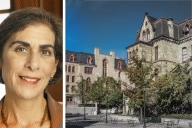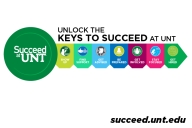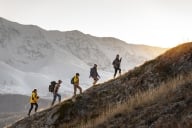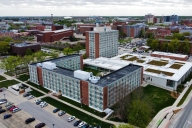You have /5 articles left.
Sign up for a free account or log in.
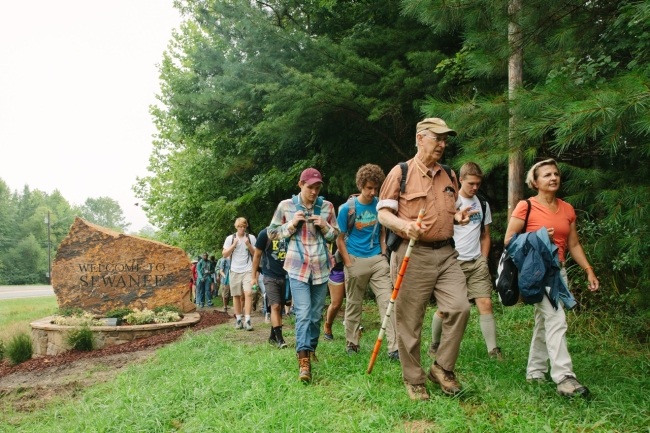
Faculty members Gerald Smith and Virginia Craighill lead students on a hike of Mountain Goat trail during Sewanee's "Finding Your Place" freshman program.
The University of the South
It begins for freshmen two weeks before classes start at the University of the South, with two orientation programs in between – but faculty members who teach the new first-year program at Sewanee call it the “anti-first-year program.”
Really, it’s more like an enhanced first-year program. It involves lectures and student bonding and campus activities and study skill acquisition. But it also involves field trips to impoverished areas and hikes and an interdisciplinary elective course and capstone projects.
“This is not about college readiness,” at least, not in the traditional sense, said Josh King, a Sewanee admissions counselor who helped develop the inaugural 10-day “Finding Your Place” program, which is now under way. “It is piecemeal of what you would find at other first-year programs, but when you combine that with the sense of place, you can really understand how community works.”
The sense of place concept can get pretty philosophical, but an assistant English professor, Virginia Craighill, explains it using a simple metaphor. Take the plateau on which Sewanee’s campus sits, she said Tuesday after returning from a hike with students up Mountain Goat Trail, named for the railroad track students took to campus in the 1850s. (At the time, it was the steepest in the world.)
Underneath the visible sandstone of Cumberland Plateau, there’s a layer of limestone, followed by conglomerate and a mixture of granite and other rocks, all shaped and scraped and created by its surrounding environment.
“They’re both understanding their landscape – where they are – but also understanding where they are in the world, what their place is here in the community of Sewanee, and then understanding at a deeper level what this place has been in history,” Craighill said. “We’re hoping that they get to see a subject matter – such as a place – through all of those lenses so that they understand there is more than one way of looking at that place, and through that broad perspective that they’ll approach their academics.”
So part of the program is a full-credit, three-month elective course (factored into tuition) called Discovering a Sense of Place -- Upon and Beyond the Domain (the Domain is Sewanee’s 13,000 acres of land), that brings together sections taught by faculty members in fields such as biology, philosophy and religion. Through a series of course sections and readings, students study the natural and artificial environments on and off campus in relation to surrounding communities, settlement, and agricultural assets and resources.
So, it’s a bit more than rock climbing, casino night and class registration. But all this, professors hope, will come together to better prepare these 106 freshmen for college (after they complete the optional PRE-orientation – a three-day outdoor program structured like a camp – and mandatory orientation, of course).
While some colleges are trying to integrate their various seminars, orientations and bridge programs, Sewanee’s seems to be an “intentional evolution” of the first-year experience, said Jennifer R. Keup, director of the University of South Carolina’s National Resource Center for the First-Year Experience and Students in Transition.
Historically, colleges’ transition programs have been “a bit of a baton passing,” Keup said: students who need extra academic preparation will go through a bridge program, then they’ll be shuffled into orientation, then handed off to residence life. Academic affairs and student affairs would each take part in some capacity, making first-year programs more collaborative than many in a sense, but never the twain would mix.
“I think this is maybe the next generation of this idea of integration,” Keup said. “There’s a lot of evolution toward these integrated programs, and that’s very exciting because it allows the students exposure to a lot of different types of programs and high-impact practices within one venue.”
Those practices include an interdisciplinary approach to academics, exposure to the outside community, civic engagement and leadership, and personal and educational connections with faculty – which, the earlier they are formed, the greater they’ll impact positive outcomes.
Craighill, who teaches the section Your Place, or Mine?: The Tension of Place in Narrative and Storytelling, has already seen a change in students’ attitude and confidence level. They’re more engaged and forthcoming with her than is typical at regular orientation, she said. One student from inner-city Chicago spoke in awe of the trail and her first-ever experience in such a place.
And it’s been educational for Craighill, too.
“I was able to drop back and talk to one student individually and learn about him or her in a way that I wouldn’t be able to do in a classroom,” she said. Which is good – because Craighill, like the other professors involved in the program, will mentor their section’s students for the next two years, until it’s time to choose a major.
The program could heighten the return on investment for Sewanee, too. Barnaby Pung, a career development specialist at Washtenaw Community College in Michigan, found in a case study that not only were students who built strong relationships at early orientation programs more likely to be engaged in college, they were more likely to maintain an affiliation with – and donate to – their college as alumni.
At the mid-sized public research university where Pung conducted his dissertation on alumni identity, students began with a two-day mid-summer orientation, returned for a three-day program and activity festival just before the semester started, and followed up with the same group in October.
“Several individuals commented on these connections with orientation leaders,” Pung said.
At a smaller institution like Sewanee, Keup said, a program such as this can streamline the first-year experience and also build a foundation for better outcomes.
“Too often, I think, first-year experience and student success programs – they’re star programs, but they’re not connected to a constellation,” she said. “It sounds like they’re trying to introduce students to the ways of thought and the ways of learning in higher education.”

